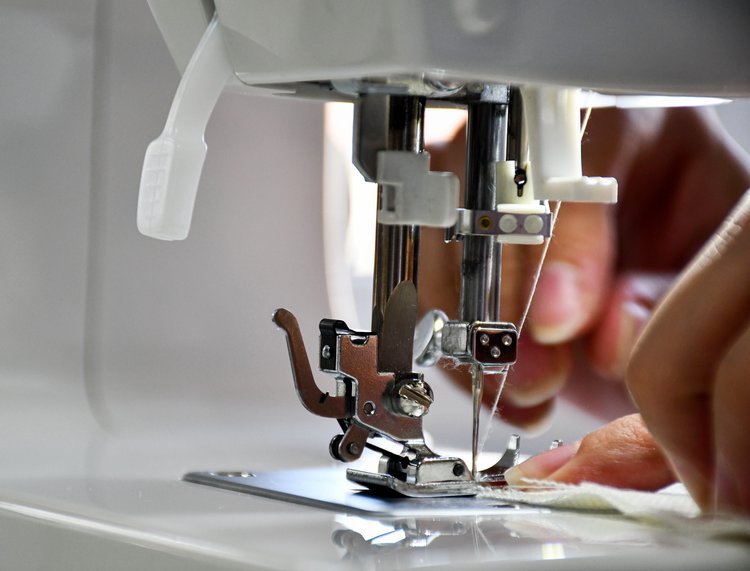The Life of a Seamstress
When I was a little girl, my mother made all my clothes. My sisters and I often had matching outfits, and I remember many Saturday nights when Mom was hemming our dresses to wear to church the next morning. I wanted to learn to sew when I was very young, and my mother let me sit at her Singer sewing machine, stitching scraps of fabric together making Barbie clothes. When I was in junior high, Mom got a new sewing machine and let me have her old one, which I kept in my bedroom on a typing table where I sewed nearly every day after school.
For my high school graduation gift, my parents gave me my own sewing machine to take with me to college. Since I was probably the only girl on campus with a sewing machine in her dorm room, I was often asked to hem jeans, stitch torn jackets, and repair other garment mishaps. I not only sewed my way through college, I also went to graduate school to study clothing design. I was a graduate assistant and was tasked to teach the freshman sewing classes, which was one of the most frustrating jobs I’ve ever had. While I was in grad school, I decided to get married, which required the responsibility of making a living in order to pay the bills in our little apartment in Tulsa, Oklahoma. While I was still taking classes, I decided to use my sewing skills to earn money. My new mother-in-law told all her friends I was for hire, and soon the little sewing room in our apartment was full of fabric, patterns, and measurements for clothing I was commissioned to make.
For many years, I sewed night and day. I made prom dresses, costumes, bridesmaid dresses, draperies, and anything that required a needle and thread. I rarely made bridal gowns, but if I was desperate enough for the money I would give in and make one or two. There were occasions when a client “accidentally” forgot her checkbook when she picked up her dress, and I let her have it anyway. Many times, the check never came. My family suffered when that happened, and I vowed to always pay workers what they earned when they had completed a job.
After ten years of marriage, I made the choice to file for divorce from my husband. My attorney told me that the only way I could convince the judge that I could fully support my two young children was to get a job with a steady paycheck. I was hired by a local non-profit to teach impoverished kids how to cook nutritious meals. I loved it so much, I began taking cooking classes, which was the beginning of my new career as a cooking teacher. I did, in fact, gain full custody of my children and I closed the door on my sewing business. I had many bittersweet memories of those years of sewing, but mostly bitter. I knew I had made a lot of people happy with their new clothes and draperies, but it took a toll on my body and emotional health.
Many years after I’d put down my needle and thread, I was asked to teach sewing to a group of women in the Dominican Republic. They were part of a microfinance program where they received small loans to start their own businesses. These women were in good standing with their loan officer and were given the reward of taking sewing lessons. When I arrived, they had ten treadle sewing machines set up outside under a tin roof. They lived in an impoverished community where there was no electricity or running water. The sewing machines, which didn’t require electricity, had been donated in hopes that the women could learn to sew as a business. For four days, I taught 29 women, with only ten machines. Knowing they likely wouldn’t have a sewing machine to use in their own homes, I taught them how to sew by hand, making rows of tiny stitches in the fabrics I had brought with me. After four days, each woman had sewn a hot pad, coin purse, and tote bag. Easter was just two weeks away, and the women all agreed they wanted to save their tote bags to carry together to church on Easter Sunday.
The following year, on a trip to Rwanda, Africa, I was in the capital city of Kigali shopping in the huge outdoor market where you could buy fruits, vegetables, beads, and brightly colored fabrics. There were dozens of women sitting at their sewing machines, lined up along the perimeter of the market. You could purchase fabrics and have these women sew them into clothing, bedding, or whatever you wanted. I noticed they were using large sheers to remove stitches in the fabrics, which is a very difficult task. I returned to Rwanda the next year with a bag full of seam rippers, a small tool for removing stitches. I handed each woman a seam ripper and told them how to use it, knowing it would make their job much easier. They had never seen such a tool and couldn’t believe I would give them a gift when I didn’t even know their names.
Occasionally, I sit at my sewing machine to hem a pair of jeans or stitch a torn pillowcase. My skills might be a little rusty, but I’m always amazed that I still remember how to thread my machine and stitch a straight line in record time. Sewing will always be an important part of my past, and I regret I never taught the skill to my daughter. I regret I didn’t enjoy it more. But I’ll never regret learning to sew next to my mother when I was a little girl, enjoying her patience with me when I made countless mistakes. I won’t regret knowing I worked hard to pay the bills and feed my family. And, although I’ll always be remembered as the dormitory seamstress, my greatest hope is that I’m remembered by those women in the Dominican Republic and Rwanda as someone who understood their struggles and cared enough to appreciate them.




